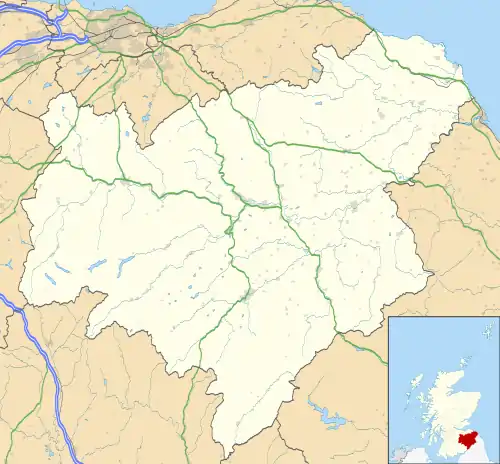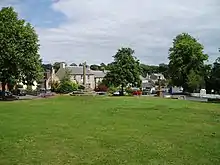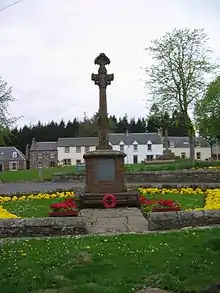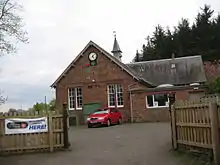Ancrum
Ancrum (Scottish Gaelic: Alan Crom) is a village in the Borders area of Scotland, 5 km north west of Jedburgh.[1][2]
Ancrum
| |
|---|---|
 Ancrum Location within the Scottish Borders | |
| Population | 392 (2001 census) |
| OS grid reference | NT625245 |
| Council area | |
| Lieutenancy area | |
| Country | Scotland |
| Sovereign state | United Kingdom |
| Post town | JEDBURGH |
| Postcode district | TD8 |
| Dialling code | 01835 |
| Police | Scotland |
| Fire | Scottish |
| Ambulance | Scottish |
| UK Parliament | |
| Scottish Parliament | |
The village — which currently has a population of around 300 — is situated just off the A68 trunk road on the B6400 which runs through Ancrum. Lilliesleaf lies 7 miles (11 km) further along the B6400 and Denholm can be reached along the unclassified road which runs parallel to the River Teviot.
The name of this place, anciently Alne-crumb, is derived from the situation of its village on a bend of the River Alne, now the Ale. There were formerly two villages distinguished by the appellations of Over Ancrum and Nether Ancrum, of the former of which nothing now remains.
The principal event of historical importance is the Battle of Ancrum Moor, which originated in an attempt made in 1545, by Sir Ralph Evers and Sir Bryan Layton, to possess themselves of the lands of the Merse and Teviotdale, which had been conferred upon them by a grant of Henry VIII., King of England. The Earl of Angus, who had considerable property in that district, determined to resist the attempt, and a battle between his forces and those of the English took place on a moor about a mile and a half north of the village, in which the latter were defeated with great loss. In this conflict, both the villages of Ancrum were burnt to the ground; the village of Nether Ancrum was soon afterwards rebuilt, but of the other nothing remains but the ruins of one or two dilapidated houses.[3]



Etymology
William J. Watson derived Ancrum from the river-name Alne + Cumbric crwm or Gaelic crom, meaning 'bend of the river Alne'.[4]
History
In the 13th century the Bishop of Glasgow William de Bondington had a residence here but the location is still being investigated.[5]
Much of the history of the area has been written about by Alexander Jeffrey in his paper to the Berwickshire Naturalists' Club.[6] There is also wider background information in his 4 volume work History and antiquities of Roxburghshire and adjacent districts, from the most remote period to the present time.[7] This latter work also has a section on Ancrum.[8]
Two local landmarks which are visible from certain areas around the village are the Waterloo Monument and the Timpendean Tower.
Ancrum sits in a loop in the Ale Water which is where the name derives from (crooked land on the Ale). The Ale joins the River Teviot just to the south which in turn then flows past Monteviot House.
The area just north of the village was the site of the Battle of Ancrum Moor in 1545 when the village was substantially destroyed. Nether Ancrum became a Burgh of barony in 1639.[2]
Notable people
- William de Bondington Chancellor of Scotland[9]
- Robert Bennet of Chesters prisoner on the Bass Rock.
- Archibald Elliot (1760-1823), architect.
- John Livingston (1603-1672), a leading Covenanter, was minister in Ancrum from 1648-1662 when he was exiled to Rotterdam. His house in Ancrum still bears a mark “The Manse of John Livingston”.
- Robert Livingston the Elder, (1654–1728), born in Ancrum, was the Secretary for Indian affairs of the New York Province and the first lord of Livingston Manor.[10]
- William Rutherford physiologist
- John Veitch (1752 – 1839), the founder of the Veitch Nurseries business, was born in Ancrum.[11]
See also
- Ancrum Old Parish Church
- Earl of Ancram
- Michael Ancram
- Ancram, New York, named after Ancrum, using an older spelling.
- Ankrum
- List of places in the Scottish Borders
- List of places in Scotland
References
- Citations
- "Zoomable 25 inch OS map with tranparancy slider". National Library of Scotland. OS. Retrieved 3 August 2019.
- "Overview of Ancrum". Gazetteer for Scotland. Retrieved 20 December 2017.
- Lewis 1851, p. 46.
- Watson 1926.
- "Ancrum dig hoping to confirm palace site". www.thesouthernreporter.co.uk. Retrieved 22 September 2019.
- Jeffrey 1868, p. 128–133.
- "History and Antiquities of Roxburghshire (4 volumes)". Retrieved 11 February 2019.
- Jeffrey 1855, p. 346–356.
- Jeffrey 1868, p. 129.
- Livingston 1910.
- Sue Shephard (2003). Seeds of Fortune - A Gardening Dynasty. Bloomsbury. p. 2. ISBN 0-7475-6066-8.
- Sources
- Chisholm, Hugh, ed. (1911). . Encyclopædia Britannica (11th ed.). Cambridge University Press.CS1 maint: ref=harv (link)
- Chisholm, Hugh, ed. (1911). . Encyclopædia Britannica (11th ed.). Cambridge University Press.CS1 maint: ref=harv (link)
- Chisholm, Hugh, ed. (1911). . Encyclopædia Britannica (11th ed.). Cambridge University Press.CS1 maint: ref=harv (link)
- Graham, A (1896). "John Livingston of Ancrum". The Border magazine. Vol. XII. Galashiels: A. Walker & son, ltd. pp. 72–74, 92–94.
- Francis H. Groome, ed. (1885). Ordnance Gazetteer of Scotland. Thomas C. Jack.
- Henderson, Thomas Finlayson (1885–1900). . Dictionary of National Biography. London: Smith, Elder & Co.CS1 maint: ref=harv (link)
- Jeffrey, Alexander (1868). History of the Berwickshire Naturalists' Club. 5. Alnwick: Henry Hunter Blair. pp. 128–133. Retrieved 11 February 2019.
 This article incorporates text from this source, which is in the public domain.
This article incorporates text from this source, which is in the public domain. - Jeffrey, Alexander (1855). The history and antiquities of Roxburghshire and adjacent districts, from the most remote period to the present time. 2. Jedburgh: W. Easton. pp. 346–356. Retrieved 11 February 2019.
 This article incorporates text from this source, which is in the public domain.
This article incorporates text from this source, which is in the public domain. - Lewis, Samuel (1851). A topographical dictionary of Scotland, comprising the several counties, islands, cities, burgh and market towns, parishes, and principal villages, with historical and statistical descriptions: embellished with engravings of the seals and arms of the different burghs and universities. London: S. Lewis and co. p. 46. Retrieved 2 January 2018.
- Livingston, Edwin Brockholst (1910). The Livingstons of Livingston manor; being the history of that branch of the Scottish house of Callendar which settled in the English province of New York during the reign of Charles the Second; and also including an account of Robert Livingston of Albany, "The nephew," a settler in the same province and his principal descendants. New York: The Knickerbocker Press. Retrieved 16 September 2016.
- Paton, John (1845). The new statistical account of Scotland. 3. Edinburgh and London: William Blackwood and Sons. pp. 241–251. Retrieved 3 January 2018.
- Paton, Henry (1885–1900). . Dictionary of National Biography. London: Smith, Elder & Co.CS1 maint: ref=harv (link)
- Power, D'Arcy (1901). . Dictionary of National Biography (1st supplement). London: Smith, Elder & Co.CS1 maint: ref=harv (link)
- Scott, Hew (1917). Fasti ecclesiae scoticanae; the succession of ministers in the Church of Scotland from the reformation. 2. Edinburgh: Oliver and Boyd. pp. 99–100. Retrieved 15 March 2019.
- Smith (1885–1900). . Dictionary of National Biography. London: Smith, Elder & Co.CS1 maint: ref=harv (link)
- Somerville, Thomas (1793). The statistical account of Scotland. Drawn up from the communications of the ministers of the different parishes. [electronic resource]. X. Edinburgh: William Creech. pp. 289–297. Retrieved 6 January 2018.
- Sprott, George Washington (1885–1900). . Dictionary of National Biography. London: Smith, Elder & Co.CS1 maint: ref=harv (link)
- Watson, William J. (1926). The history of the Celtic place-names of Scotland, being the Rhind lectures on archaeology (expanded) delivered in 1916, by William J. Watson ... Published under the auspices of the Royal Celtic society. Edinburgh: W. Blackwood & sons, ltd. pp. 467–468. Retrieved 4 August 2019.
External links
| Wikimedia Commons has media related to Ancrum. |